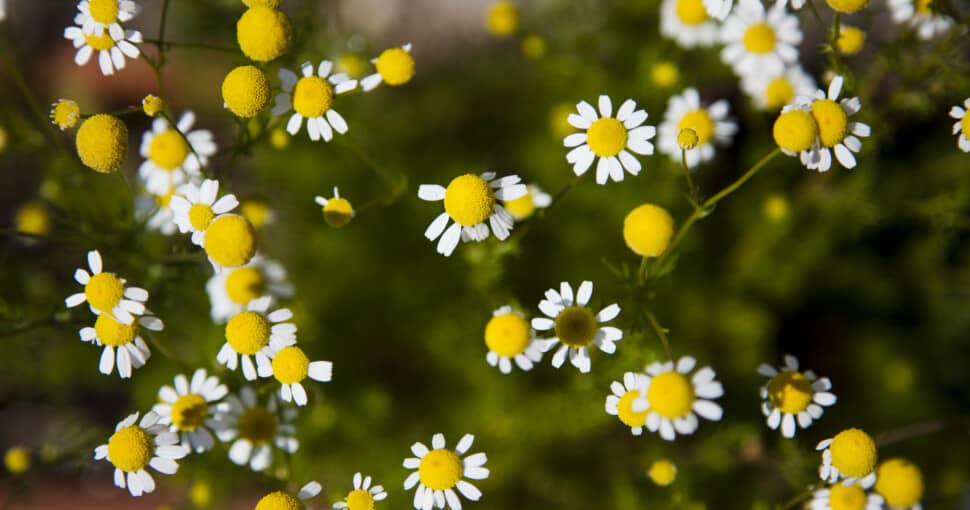There are two varieties of chamomile commonly accepted as true chamomile. They are German chamomile (Matricaria chamomilla), also called blue chamomile, and Roman chamomile (Chamaemelum nobile), also called common chamomile. These are two varieties referred to when speaking of chamomile tea or the medicinal application of chamomile.
Contents
There are roughly twenty-five species of chamomile in the genus Matricaria. German chamomile is an annual plant in the Asteracea family and differs from plants that look similar in a few ways.
German chamomile grows to roughly twenty inches with small compound flowers compiled of an arched cluster of yellow tubular flowers surrounded by white ray florets. When cut in half, these flowers are hollow inside. Both varieties have a very distinct chamomile scent when crushed.
Roman chamomile belongs to the Chamaemelum genus but is similar to German chamomile in its appearance and chemical compounds. Roman chamomile differs from German, as it is a smaller plant that only grows between five and twelve inches tall and is perennial. The flower is almost identical to German chamomile, but a flower cut in half is not hollow, it has a pith-filled center.
The leaf structure of both varieties of chamomile looks similar at a glance, but on closer inspection, the German chamomile is dark green without any hairs, and biologically the shape is classified as linear-filiform. Roman chamomile leaves are lighter green and may have a fine, downy hair covering, and the leaf shape is described as finely pinnate. Many other plants look similar to these two varieties, though.
1. Spanish Chamomile
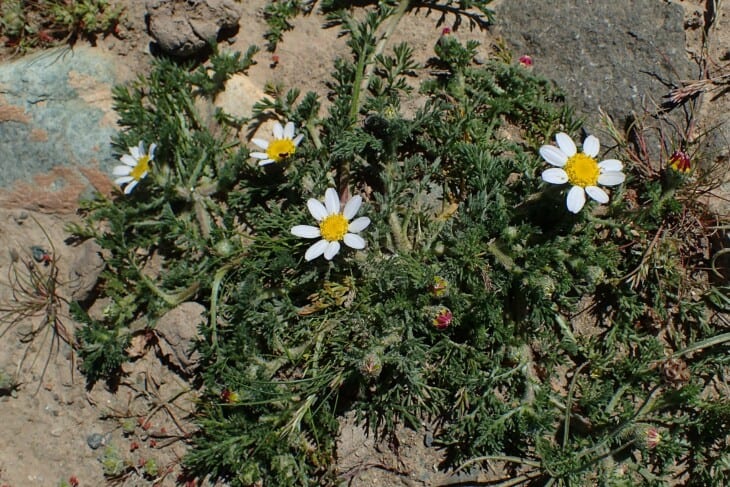
Spanish chamomile (Anacyclus pyrethrum) also goes by names like Bertram or pellitory and is also a member of the Asteraceae plant family. Unlike German and Roman chamomile that were native to Europe, Spanish chamomile has its origins in North Africa and the Mediterranean. Over time, all these varieties have now become naturalized on most of the continents.
Spanish chamomile is a perennial plant with white flowers that seem very similar to true chamomile, but the disc flower center is not as domed, and the leaves are more fern-like with a grey-green color. On closer inspection of the flower, you will note that the top part of the ray flowers is pure white, but the underside is purple. This purple color becomes quite obvious when the flower folds closed.
2. Stinking Chamomile
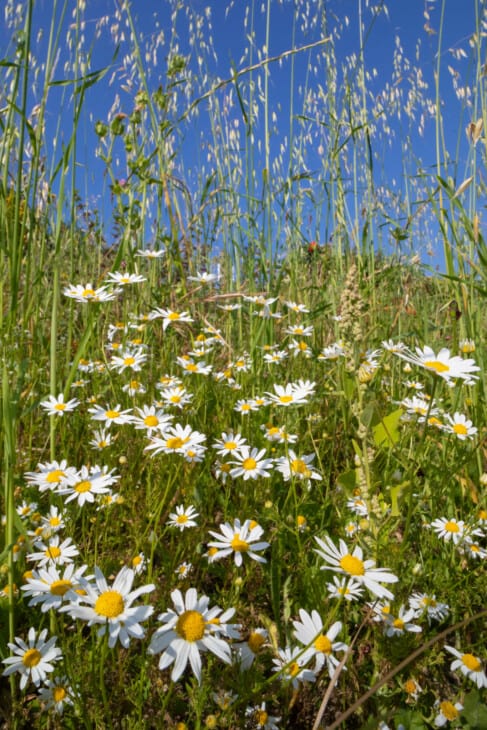
Stinking chamomile (Anthemis cotula), or mayweed, is an annual plant in the Anthemis genus of plants, including roughly one hundred and sixty species. While the stinking chamomile flower looks very similar to true chamomile, the scent of this plant will ensure that you do not make an incorrect identification.
Aside from the smell, described as acrid, the flowers can be differentiated from true chamomile by a three-toothed shape at the end of each white ray flower petal. The plant grows to a height that ranges between twelve and twenty-four inches. Despite the scent, stinking chamomile is used medicinally for humans but can be toxic to pets.
The leaves grow directly from the stem without a leaf stalk, and the shape is classified as pinnate. The leaves are very fine and similar to fennel, which explains why this plant is also sometimes called Dog’s fennel.
3. Scentless Chamomile
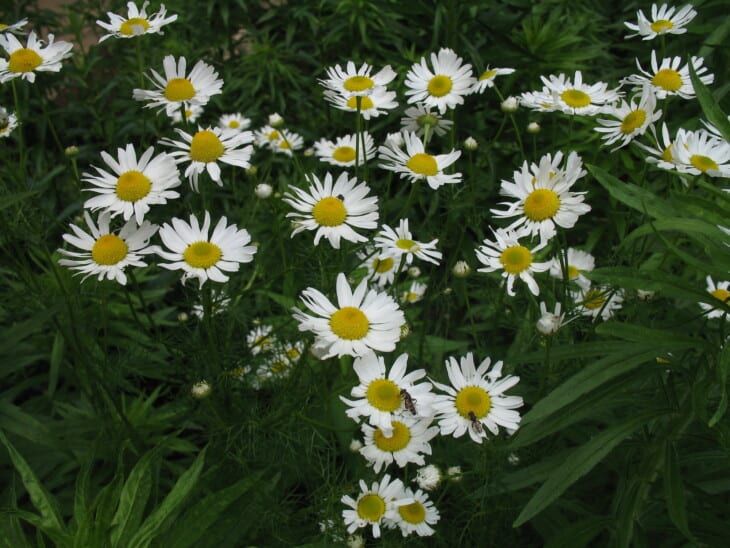
Scentless chamomile (Tripleurospermum inodorum) also goes by names like false chamomile and Baldr’s brow. The distinctive chamomile-shaped flower is born on long flower stalks on a plant that grows up to thirty-two inches tall. Scentless chamomile is an annual plant in the Asteracea family that has been declared a weed in many countries.
Scentless chamomile flowers’ composition is similar to true chamomile, with a much flatter cone flower section than true chamomile flowers. Unlike German chamomile, the flower is solid when cut in half. The leaves have a fine, feathery shape that is hairless in mature leaves.
Historically this plant was used medicinally but has fallen out of favor compared to true chamomile. The popularity and spread of scentless chamomile can be attributed to Norse mythology that provided the name Baldr’s brow to this plant. Presumably, its beauty and bright white flowers were compared to the brightness of Baldr, who was Odin’s second son.
4. Pyrethrum
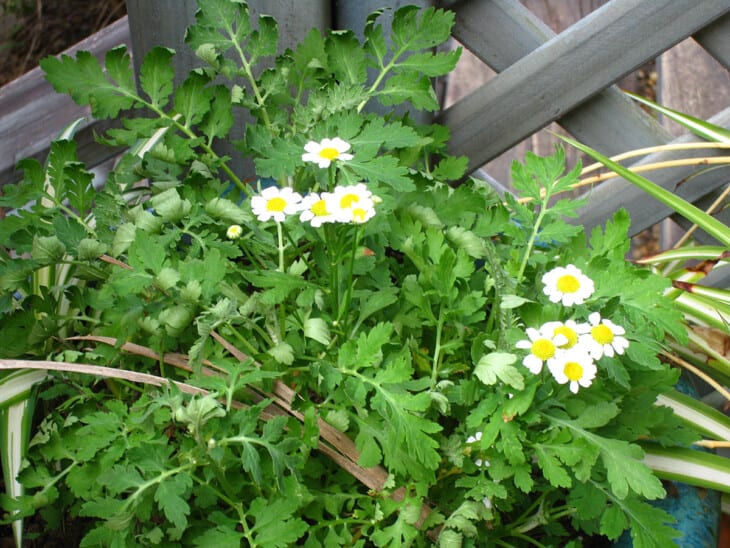
Pyrethrum (Tanacetum cinerariifolium), also known as Dalmatian pellitory or pyrethrum daisy, has a flower that is very similar to chamomile. The ray flowers are fuller than chamomile, and the disc floret section in the center is smaller and not conical.
The name Dalmatian pellitory refers to the Balkan area that this plant is native to. These dainty perennial flowers grow on plants with blue-green fern-like leaves and can grow as tall as twenty-three inches.
Pyrethrum has spread and is a crop plant in various African countries, India, and Australia due to its use as an insecticide. The active compound pyrethrin is extracted from the seed casings and powdered to produce a resinous compound for the production of insecticides. The use of pyrethrin is considered safe for food crops, and in its natural form, it is an organic pesticide.
5. Cretian Mat Daisy
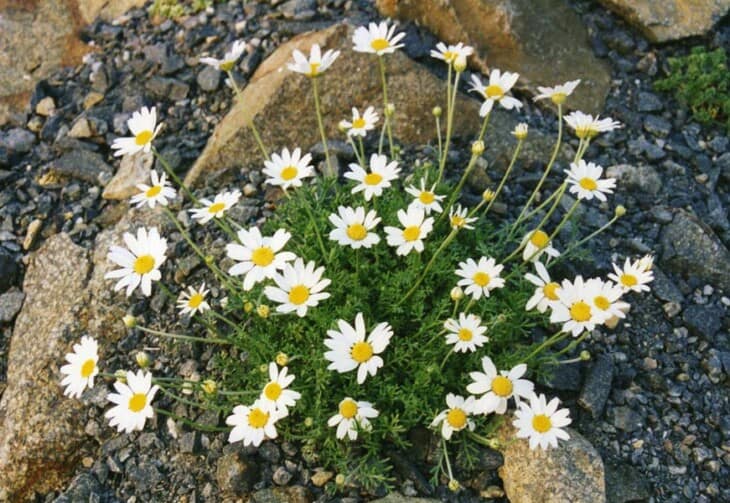
The Cretian mat daisy (Anthemis cretica), also called white mat chamomile or snow carpet, is a plant with about twenty subspecies that grows in the Mediterranean regions. Many of these subspecies cannot be told apart. The Cretian mat daisy is a perennial in the Asteracea family that grows in clumps to about fifteen inches in height.
The white flowers of this plant have a flat yellow center of disc florets, unlike the cone shape centers of true chamomile plants. Flowers are borne on long flower stems that extend above the foliage. Leaves are grey-green and fern-like.
Many plants in the Anthemis genus are host plants to insects in the Lepidoptera order. This means that planting these plants could attract the larval stage of moths from this order to your garden. Cretian mat daisies will also attract other pollinators, like bees and butterflies, into your garden when they flower in spring and summer.
6. Sneezewort Yarrow
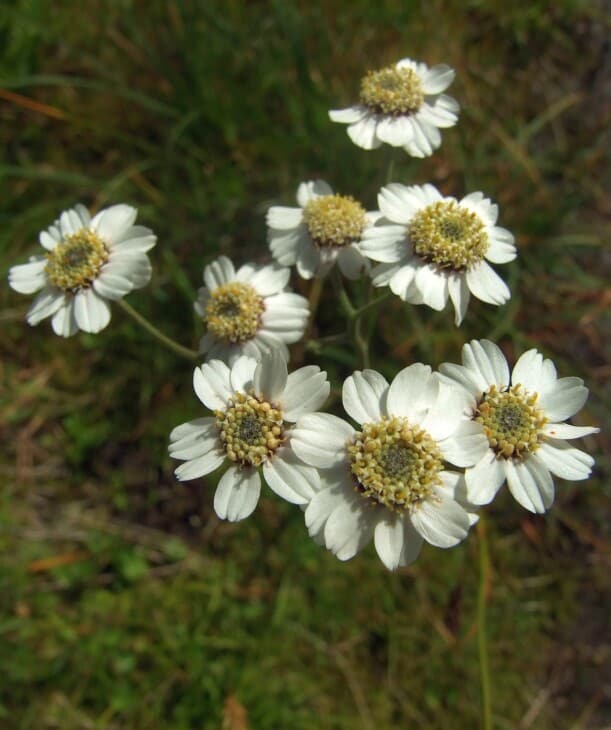
Sneezewort yarrow (Achillea ptarmica) also has common names like European pellitory, sneezeweed, and white tansy. Sneezewort is a perennial plant in the Asteracea family that produces clusters of white flowers with yellow centers. The clusters of flowers are the first characteristic to tell it apart from chamomile plants.
Sneezewort grows to between one and a half and two feet tall. This is much taller than any chamomile variety. The leaves also differ from chamomile as sneezewort has a lance-shaped leaf with a finely serrated edge.
Like chamomile, this plant is grown for some benefits it provides to the grower. The leaves of this plant can have a numbing effect when chewed, providing relief from toothache. The leaves can also be used as an insect repellant.
Related: 5 Plants That Look Like Yarrow
7. Feverfew
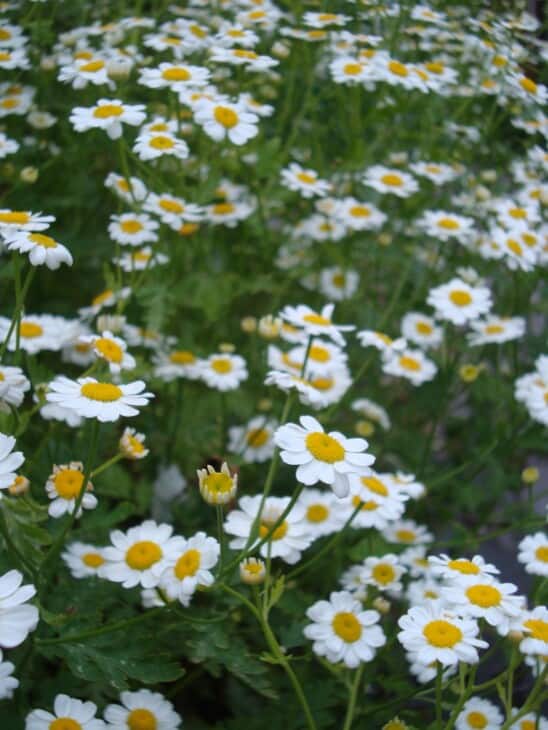
The Feverfew plant (Tanacetum parthenium) is a perennial plant in the Asteracea family. The distinctive white and yellow compound flowers look similar to chamomile flowers, but the white ray florets are shorter and more densely arranged than those of chamomile flowers. The yellow disc florets have a tubular shape absent in true chamomile.
Feverfew grows to around fifteen to eighteen inches tall and bears clusters of flowers arranged in clusters with a growth pattern known as a corymb. The effect of this growth pattern is the impression that all the plant flowers appear on the same level.
The leaves of the feverfew plant are broader than chamomile plants. The leaf pattern of feverfew is classified as pinnate as they are indented but not as vigorously indented as chamomile leaves. Feverfew is a popular traditional medicinal plant used for its pain-relieving properties. It is most frequently used to treat migraine headaches, stomach aches, and rheumatoid arthritis.
8. Wild Chamomile
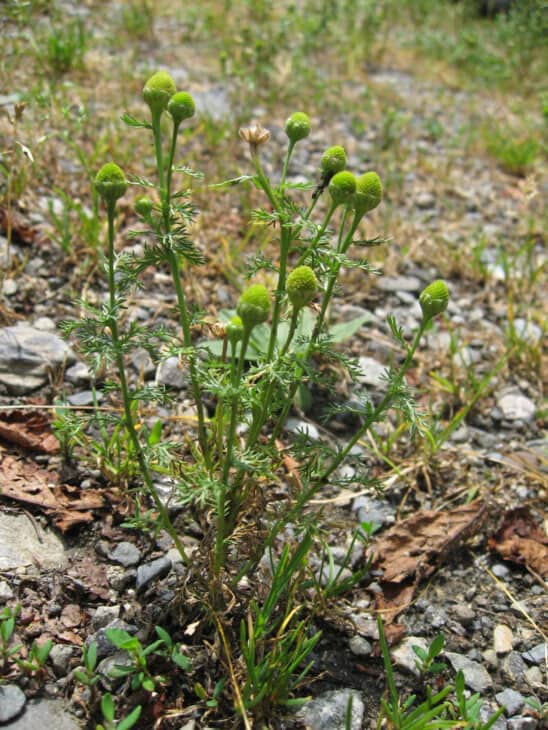
Wild chamomile (Matricaria discoidea) goes by names like pineapple weed and disc mayweed. The similarity between Wild chamomile and true chamomile is mainly in the shape of the disc flowers and the leaves, as white ray florets are entirely absent in this flower. Growing two to sixteen inches tall, these plants are very similar to chamomile in every other way.
Pineapple weed has spread from its native habitat in northeast Asia and has become naturalized on most continents, including America and Britain. Pineapple weed crows are readily in disturbed soil and can be found on roadsides, near hedgerows, along footpaths, and in gardens.
As the name suggests, the leaves and flowers have a strong pineapple fragrance and are often included in salads or used as tea. The plant is not only fragrant but also has a sweet taste before the plant goes to bloom. Traditionally false chamomile has also been used to soothe gastrointestinal complaints and treat fevers.
9. Ox-eye Daisy
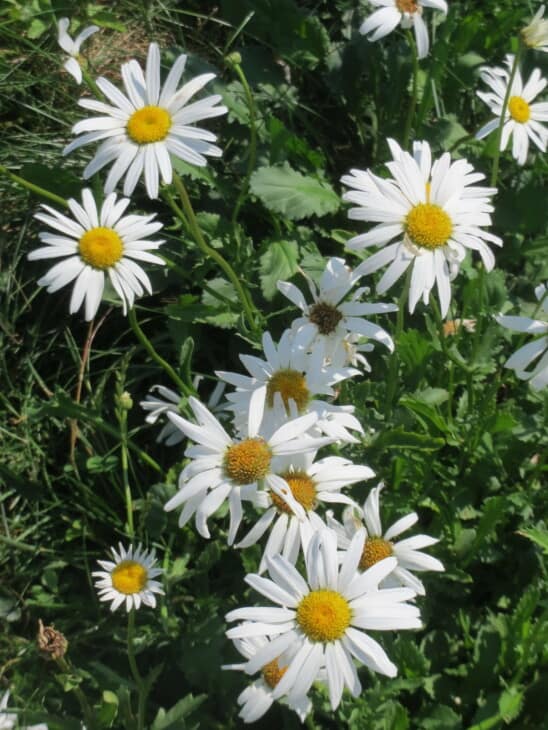
Ox-eye daisies (Leucanthemum vulgare) are also known as dog daisies, moon daisies, or marguerites. These chamomile look-alikes are native to Europe and Asia, but these perennials have spread to North America and Australia.
The compound flowers have long white ray flowers surrounding the bright yellow disc flowers. The flowers are much larger and flatter than chamomile flowers. Ox-eye daisy bushes grow to about thirty-one inches. The leaves close to the base of the plant are spoon-shaped, with many lobes. The leaves higher on the plant are smaller and differ in shape.
Related: Are Daisies Poisonous?
The whole ox-eye daisy plant is edible, and the leaves are a good source of vitamin C. The flowers are traditionally used to treat coughs, indigestion, and stomach ulcers.

